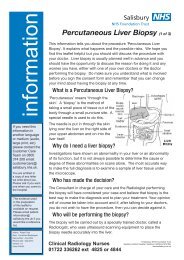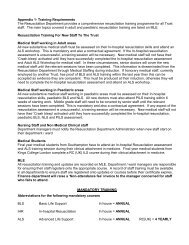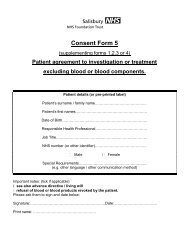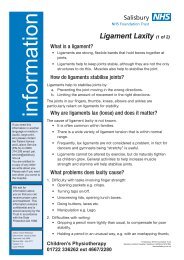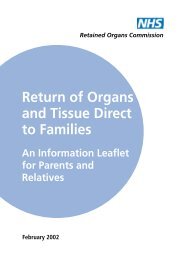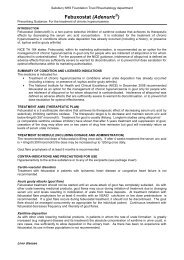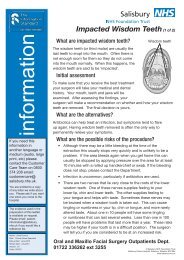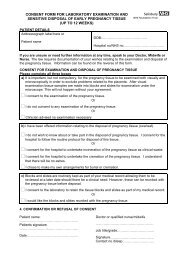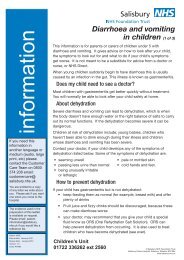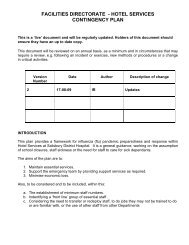Oral sodium Clodronate - ICID - Salisbury NHS Foundation Trust
Oral sodium Clodronate - ICID - Salisbury NHS Foundation Trust
Oral sodium Clodronate - ICID - Salisbury NHS Foundation Trust
You also want an ePaper? Increase the reach of your titles
YUMPU automatically turns print PDFs into web optimized ePapers that Google loves.
<strong>Salisbury</strong> <strong>NHS</strong> <strong>Foundation</strong> <strong>Trust</strong> Drugs and Therapeutics Committee<br />
SUPPORTING INFORMATION<br />
Summary of condition and licensed indications.<br />
The indication covered by this shared care guideline is, the prevention of hypercalcaemia, bone pain and<br />
fractures in patients with multiple myeloma<br />
Treatment Aims (Therapeutic plan)<br />
Current UK guidelines recommend that all patients with symptomatic multiple myeloma receive<br />
bisphosphonate therapy, whether bone lesions are evident or not, as randomised studies have shwon<br />
significant reductions in bony complications (pain, pathological fracture, radiotherapy) when these drugs are<br />
administered. Three bisphosphonates, pamidronate, zoledronate (Zometa ® ) and clodronate (Bonefos ® ) are<br />
licensed for this indication, and there are currently no data to indicate superiority of any of these three<br />
agents. Sodium clodronate has the advantage of oral administration, and is therefore the preferred first line<br />
treatment for most patients. Treatment should be continued for at least 2 years, although it is current practice<br />
to continue these drugs indefinitely while the patient is still undergoing active treatment and follow-up. It is<br />
therefore desirable that this drug be subject of a shared care agreement.<br />
Treatment Schedule (including dosage and administration)<br />
The patient will be initiated and stabilised on the drug by the Consultant Haematologist responsible for their<br />
care. The licensed dose for <strong>sodium</strong> clodronate (Bonefos ® ) is 1.6g in single or two divided doses. The drug is<br />
available as capsules of 400mg and tablets of 800mg. Patients should avoid food, particularly calciumcontaining<br />
products such as milk, for 1 hour before and after each dose. Iron and mineral supplements, and<br />
antacids, should also be avoided, and an adequate fluid intake maintained. Treatment should be continued<br />
for at least 2 years, although current practice is to continue treatment indefinitely whilst the patient remains<br />
under active haematological follow-up. Most patients will remain under active haematological follow-up, with<br />
the consultant deciding when treatment may be discontinued, but patients should be referred back if<br />
symptoms of drug intolerance (nausea, diarrhoea, skin reactions, bronchospasm, hypocalcaemia, renal<br />
impairment, osteonecrosis) develop.<br />
Contra-indications and precautions for use<br />
Contraindications: acute gastrointestinal inflammatory conditions, pregnancy, breastfeeding.<br />
Cautions: monitor renal and hepatic function during use, also monitor calcium and phosphate periodically.<br />
Renal dysfunction reported in patients receiving concomitant NSAIDs. Maintain adequate fluid intake during<br />
treatment. Consider preventive dental treatment before initiating clodronate because of risk of osteonecrosis<br />
of the jaw. Adequate oral hygiene should be maintained during and after treatment.<br />
Side-effects<br />
The commonest side effects are: nausea, diarrhoea, skin reactions, bronchospasm<br />
Monitoring<br />
Parameter Frequency of monitoring Action (adjustment of dose by specialist<br />
and referral back to hospital by GP if<br />
acute renal of hepatic dysfunction )<br />
Renal function<br />
Hepatic function<br />
Calcium/phosphate<br />
At least every 3 months (responsibility of<br />
Consultant Haematologist)<br />
Drug Interactions<br />
Absorption reduced by antacids, calcium salts and oral iron<br />
Increased risk of hypocalcaemia when given with aminoglycosides<br />
Cost<br />
At current prices, one year's treatment with medicine at the dose is £2039.04<br />
References<br />
50% dose if CrCl 10-30ml/min<br />
Stop if CrCl



